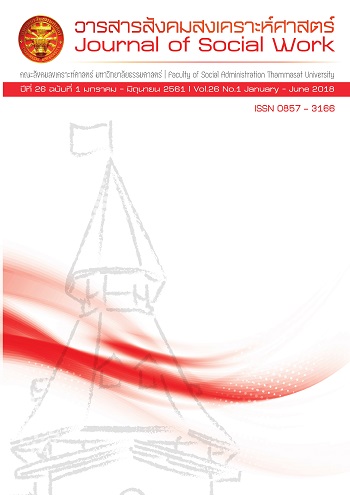ทัศนะของนักศึกษาต่อการคุกคามทางเพศในสถานศึกษา
คำสำคัญ:
ทัศนะต่อการคุกคามทางเพศ, นักศึกษา, การคุกคามทางเพศในสถานศึกษาบทคัดย่อ
การศึกษาเรื่อง “ทัศนะของนักศึกษาต่อการคุกคามทางเพศในสถานศึกษา” มีวัตถุประสงค์เพื่อศึกษาทัศนะของนักศึกษาต่อการคุกคามทางเพศในสถานศึกษา และเพื่อแสวงหาแนวทางในการป้องกันและแก้ไขการคุกคามทางเพศในสถานศึกษา กลุ่มประชากรในการศึกษาครั้งนี้ คือ นักศึกษาปริญญาตรีที่ลงทะเบียนเรียน 3 วิชา ได้แก่ CJ311 CJ313 และ CJ315 ภาคการศึกษาที่ 1/2559 สถิติที่ใช้ในการวิเคราะห์ข้อมูล ได้แก่ สถิติเชิงพรรณนา โดยใช้ค่าอัตราส่วนร้อยละ (Percentage) ค่ามัชฌิมเลขคณิต (Mean) และใช้ค่าการกระจายหาค่าส่วนเบี่ยงเบนมาตรฐาน (Standard Deviation) ผลการศึกษาสรุปได้ดังนี้
นักศึกษามีทัศนะโดยรวมต่อการคุกคามทางเพศในสถานศึกษาทั้ง 3 ด้าน อยู่ในระดับปานกลาง ( = 3.66) โดยมีทัศนะต่อผลกระทบจากการคุกคามทางเพศอยู่ในระดับสูง (
= 3.94) รองลงมาเป็นทัศนะด้านความคิดเห็นทั่วไปต่อการคุกคามทางเพศในระดับ (
= 3.61) และอันดับสุดท้ายคือด้านปัจจัยที่มีอิทธิพลต่อการคุกคามทางเพศในระดับ (
= 3.43)
ข้อเสนอแนะในการศึกษาครั้งนี้ ได้แก่ 1. สถานศึกษาควรส่งเสริมความรู้ความเข้าใจเกี่ยวกับการคุกคามทางเพศให้แก่นักศึกษา 2. งานกิจกรรมนักศึกษาควรกระตุ้นให้มีการจัดกิจกรรมนอกหลักสูตรเกี่ยวกับการคุกคามทางเพศ 3. สาขาวิชาโทการบริหารงานยุติธรรมควรจัดให้มีกิจกรรมหรือการเรียนรู้นอกห้องเรียน 4. ควรให้นักศึกษาปรับทัศนะเกี่ยวกับปัจจัยที่ส่งผลต่อการคุกคามทางเพศว่าไม่ได้มาจากการแต่งกายหรือคำพูดของเหยื่อ 5. สถานศึกษาควรจัดสภาพแวดล้อมไม่ให้เกิดมุมอับหรือมุมลับตาคน 6. สถานศึกษาควรสนับสนุนให้นักศึกษาและบุคลากรในสถานศึกษาช่วยกันสอดส่องและรายงาน หากพบเห็นการคุกคามทางเพศภายในสถานศึกษา 7. ครอบครัวและสถานศึกษาควรร่วมมือกันปลูกฝังค่านิยมที่เหมาะสมให้กับนักศึกษาในเรื่องของความเท่าเทียมทางเพศระหว่างเพศชายและเพศหญิง 8. สถานศึกษาควรมีหน่วยงานกลางที่ทำหน้าที่รับเรื่องร้องทุกข์ หรือให้คำปรึกษาอย่างเป็นรูปธรรม รวมไปถึงเปิดช่องทางอื่นๆ ในการรายงานปัญหาหรือร้องเรียน
เอกสารอ้างอิง
Axelrod, Anne. (2001). Hostile Hallways: Bullying, Teasing, and Sexual Harassment in School. Washington DC: American Association of University Women Educational Foundation. P.32-36.
Moorhead, G., & Griffin, R. W. (1998). Organizational behavior: Managing people and organizations. Boston: Houghton Mifflin.
http://www.healthinfo.in.th/hiso5/report/download.php?name=thai2009_17. 6 ภัยทางเพศในสถานศึกษา ถึงเวลาต้องแก้ไขอย่างเป็นระบบ. เข้าถึง วันที่ 18 ตุลาคม 2559
ดาวน์โหลด
เผยแพร่แล้ว
รูปแบบการอ้างอิง
ฉบับ
ประเภทบทความ
สัญญาอนุญาต
ผลงานที่ตีพิมพ์ในวารสารสังคมสงเคราะห์ศาสตร์เป็นลิขสิทธิ์ของวารสารสังคมสงเคราะห์ศาสตร์ มหาวิทยาลัยธรรมศาสตร์ และวารสารสังคมสงเคราะห์ศาสตร์ มหาวิทยาลัยธรรมศาสตร์ ขอสงวนสิทธิในการเผยแพร่ผลงานที่ตีพิมพ์ในแบบรูปเล่มและทางสื่ออิเล็กทรอนิกส์อื่นใด
บทความหรือข้อความคิดเห็นใดๆ ที่ปรากฏในวารสารสังคมสงเคราะห์ศาสตร์เป็นความรับผิดชอบของผู้เขียนโดยเฉพาะ คณะสังคมสงเคราะห์ศาสตร์ มหาวิทยาลัยธรรมศาสตร์ และบรรณาธิการไม่จําเป็นต้องเห็นด้วยหรือร่วมรับผิดชอบใดๆ



